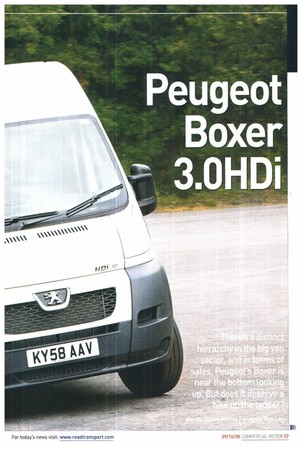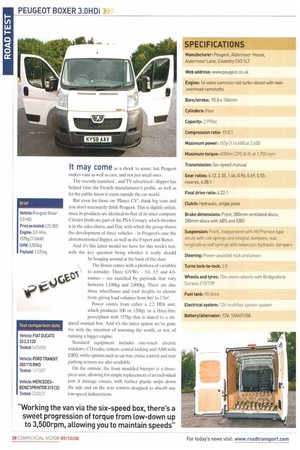Peugeot Boxer 3.0H i
Page 37

Page 38

Page 39

Page 40

If you've noticed an error in this article please click here to report it so we can fix it.
It may come as a shock to some. but Peugeot makes vans as well as cars, and not just small ones.
The recently launched-and TV advertised Sipper has helped raise the French manufacturer's profile, as well as let the public know it exists outside the car world.
But even for those on 'Planet CV', think big vans and you don't necessarily think Peugeot. This is slightly unfair. since its products are identical to that of its sister company Citroen (both are part of the PSA Group), which thrashes it in the sales charts, and Fiat, with which the group shares the development of three vehicles in Peugeot's case the aforementioned Bipper, as well as the Expert and Boxer.
And it's this latter model we have for this week's test. with the key question being whether it really should be hanging around at the back of the class.
The Boxer comes with a plethora of variables to consider. Three GVWs 3.0, 3.5 and 4.0tonnes are matched by payloads that vary between 1,100kg and 2,000kg. There are also three wheelbases and roof heights to choose from, giving load volumes from 8m' to 17m3.
Power comes from either a 2.2 HDi unit, which produces 100 or 120hp, or a three-litre powerplant with 157hp that is mated to a sixspeed manual box. And it's the latter option we've gone for, with the intention of assessing the worth, or not, of running a bigger engine.
Standard equipment includes one-touch electric windows. CD/radio, remote central locking and ABS with EBD, while options such as sat-nay, cruise control and rear parking sensors are also available.
On the outside, the front moulded bumper is a threepiece unit, allowing for simple replacement of an individual part if damage ensues, with further plastic strips down the side and on the rear corners designed to absorb any low-speed indiscretions. The Boxer is also available in chassis and double-cab, for the 300 HDi 100 panel van. Our test model costs £22,050. Warranty is 36 months/100,000 miles.
Productivity While on paper, a larger engine displacement and higher horsepower should mean an equally significant fuel consumption increase, we're finding that when combined with a big van, that extra low-down torque also contributes to competitive fuel consumption, as you don't have to wind it up quite as much to get going!
So a return of 30.2mpg for a laden run for a van sporting a three-litre engine is a fair effort, especially since it beats Mercedes' 311CDI Sprinter and Citroen's Relay 35 120 — recording 29.4 and 29.8 respectively. The unladen figure at 31.8mpg was also respectable, although it gives some indication of bias towards coping with a full load.
In the business end, there's a level of practicality thanks to a low-loading lip that makes entry and exiting a smooth operation, while the width between the wheel-arches is among the best-in-class.
The near-flat side walls also combine well with the load bed to allow good usage of the space available. Further help to the Boxer's cause come in the form of tic-down points along the floor, while along the lower side walls plastic lining panels help absorb the knocks. We also like the release buttons on the rear doors that allow them to open from 90 degrees to 180 degrees; easily the most user-friendly we've come across, saving your fingers from having to mess with the hinges.
Cab comfort Peugeot has considered driver comfort and practicality when designing the Boxer's interior one glance across the dashboard is testament to this. It provides strong levels of storage, as well as functional and simple to navigate ergonomics that allow the driver to become familiar with their environment.
What hasn't been addressed is the less-than-generous driver access, which is obscured by the steering wheel, with entry and exiting hampered. While not overtly detrimental, this issue is prevalent in the driving position. Achieving a decent setting by using the multi-adjustable seatandtilt-adjustable steering wheel is easy enough, but pedal spacing is a little tight due to limited footwell space. Gripe out of the way, the Boxer provides all that the modern driver needs. There are more glove boxes and cubbies than you can shake a stick at, with the top unit also providing a chiller function for drinks and the like. Two clipboards one mounted centrally and one integrated into the middle seat allow you to stay on top of the admin. too.
On the move. the Boxer is comfortable and secure, with a strong level of build quality (although not class-leading) helping the cause. However, the lack of a standard full bulkhead increases rear noise. Forward visibility is good because of the high seating position and long sloping windscreen, which complement the dual-lens wing mirrors, that offer excellent rear vision.
On the road There's an easy nature to the Boxer's driving character, which makes it an undemanding machine to drive, and in the middle of this is the eager three-litre engine. Anyone who's driven a van that needs to permanently teeter on the red line to get even a suggestion of performance out of it will testify that having little in the way of power can be tiresome and time consuming. We're not advocating that this engine is the one for all cases we've tested the 2.2-litre option and that operates well enough but, if you like your payloads heavy and cover a variety of road types, this variant certainly soaks up these factors with aplomb.
Working the van via the six-speed box, there's a sweet progression of torque from low-down up to 3,500rpm, allowing you to maintain speeds and progress without too much foot exertion, but it does peter off noticeably near the red line. Fortunately, the chassis copes with the extra power in its stride, with no surprises when pushed.
It turns in with precision, due in part, to the accurate steering, and grips well without any drama when approaching the limit; and understeering controllably to work off excess speed.
There's also good news for the ride, which is assisted by strong damping to absorb bumps and undulations, while insulating the driver from the action below. Unlike some rivals, you feel like you're driving a big van it doesn't feel unwieldy, but fails to shrink in size when on the move. •








































































































































































